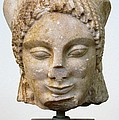Looking for design inspiration? Browse our curated collections!
Joined
2011
Followers
26
Visitors
465,051

Kore
The statuary type of the kore is the female equivalent of the kouros. Kore represents female grace and modesty. Standing frontally, she, in contrast to the kouros is shown dressed, either in the heavy Doric peplos or in a thin Ionic chiton and mantle. The legs are parallel, with one slightly advanced. One arm, usually the left one, is lowered, the hand pulling the dress in order to walk. The right arm is extended or rests on the chest, holding an offering (small animal, bird, fruit) of flower. On her head she wears a diadem or wreath. The coiffure shows great variety, with several ways of rendering the hair on the calotte and the long locks falling on the back and chest. In contrast with the kouroi, where he manifests his ability to convey human anatomy, in the case of the korai the sculptor experiments with the rendering of drapery in association with the body. The statuary type of kore is known since the Daedalic period. The earliest examples of korai come from Ionia and the islands (Chios, Samos, Cyclades). From the mid-sixth century BC, they become the most important theme of Attic sculpture. Korai are usually votive in nature, offerings to the patron goddess Athena. The last korai date to ca. 490 B.C. The new era that begins for Greece and particularly Attica after the victorious Persian wars will lay a new base for sculptors and lead the way to the splendid Classical art